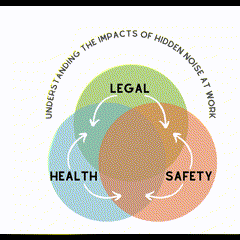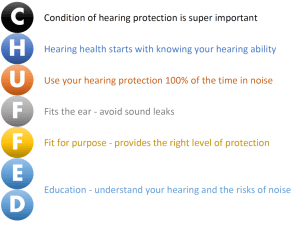This article is 2nd in our series on hidden noise, written with and for the UK Hearing Care Association (UKHCA). Our first piece defined Hidden Noise and how it may be damaging the health of millions more UK workers than has been generally accepted.This follow-up piece presents 5 simple ways why Noise and Hidden Noise at Work matters in your organisation:
- how hidden noise could be costing your organisation
- the costs of hidden noise
- where to find out more about addressing hidden noise
Organisations Are Becoming Hearing Health Aware
“(I’m) seeing more and more articles and evidence around noise exposures outside traditional ‘noisy’ industry. Are people finally becoming aware of both health and wellbeing risks and the need to address these challenges?”
This quote by Clare Forshaw, Occupational Health & Hygiene Partner at Park Health & Safety and founder of the UK Hearing Conservation Association (UKHCA)[1] referenced an HSE [2] campaign, showing noise levels in London eateries were the highest in Europe and second only to San Francisco. The report said that
“This highlights another risk that hospitality professionals face as part of their vocation, adding to long antisocial hours and tough environmental conditions on a daily basis – all of which can contribute to stress levels and negatively impact mental health”.
The noise data was released by SoundPrint, a global app that allows users to search for restaurants, cafés and bars by sound levels on a noise database submitted by other users. Although some would decry the accuracy of devices used to collect social-data, you can’t argue that phones, wearables and apps are democratising noise measurements.
Employers need to take note that in parallel, social media is creating awareness of the issue around noise induced hearing loss (NIHL) and related health issues. And this is the important bit, given that NIHL is the worlds’ most common industrial disease (according to the ILO) and wholly avoidable.
So if more organisations are sitting up and taking notice – what do they appreciate, that others continue to miss?
Point 1: More organisations are hearing health aware. It’s easier than ever to be a leader, a fast follower and not a laggard.
A Framework for Evaluating Hidden Noise at Work
Hidden Noise: Legal Considerations
The Control of Noise at Work Regulations 2005 (‘NAW’) is the foundation of occupational hearing care in the UK. It reflects scientific understanding that excess noise can be harmful. And – as in all legal cases – the distinction between ignorance, willful ignorance or avoidance may not be obvious or therefore any defence – particularly since NAW is pretty clear!
Some elements to be aware of:
- NAW applies to all organisations (with certain exceptions)
- Harmful noise can come from any source and is not limited to “industrial” sounds
- NAW requires organisations to assess noise risk; eliminate (or control) the risks; supply PPE, surveillance and training
- NAW is policed by the HSE and local EHO’s
- Find out more here
NAW (2005) therefore provides a codified and clear structure explaining who, when and why your organisation should take action to protect hearing in the workplace. A failure to address noise – whether hidden or not – falls foul of this legislation, and thereby opens organisation up to penalties.
POINT 2 – There is a clear legal requirement for understanding hearing health in the workplace.
Hidden Noise: Safety at Work
Good hearing is a lifesaver. Hearing’s significant advantage is that it works effectively without line-of-sight. (The semaphore ringtone never caught on, surprisingly enough).
Which means there can be few people on the planet who have not avoided a mishap due a timely warning or relied on their hearing to alert them to an unseen danger. Anyone remembering the Green Cross Code of “Stop, Look & Listen” will understand this –
Teaching kids to listen for danger and the Green Cross code is thought to be responsible for saving the lives of 250,000 children and halving the number of kids killed in road accidents.
More than this, hearing can help localise sound and is intimately linked to our sense of balance – both useful to keep you safe.
From a longer-term perspective, hearing is human-kind’s primary training mechanism. The author recalls a builder during surveillance audiometry (with a previous career de-scaling cement kilns) happily admitting that if he wasn’t at the front of a toolbox talk – where he could hear – he may as well not have been there at all. He – of course – had no idea what he missed out on over the years. More likely than not, this included safety training or instructions.
Point 3 – Hearing is a lifesaver. Without understanding an individual’s hearing, you can’t have a full picture of their risk.
Hidden Noise: Health, Wellness & Retention
If safety operates to keep us unharmed in the short term, hearing health has been shown to have a demonstrable impact on worker retention, absence, wellness, mental health and productivity over the longer term. This is because hearing is human’s primary communication channel with nearly 80% of the workday spent communicating and 45% of this spent listening[6]
You will note that we have included examples of the effects of tinnitus below, since a major cause of tinnitus is excess noise, the demographic for tinnitus is wider than hearing loss and people are generally more aware/ willing to accept that they suffer tinnitus than a hearing loss.
Specific examples include:
- Hearing And Staff Retention – Nearly 4 times as many hearing impaired respondents cite stress and burn-out as the reasons for calling in sick, as compared those with normal hearing.
- Hearing And Staff Absence – tinnitus patients miss work more than double the time of the average German employee (10.9 days).
- Hearing and Fatigue A Danish survey Danish Institute for Social Research found that around 15% percent of hearing impaired workers are so fatigued by the end of the day they have no energy left for leisurely pursuits

- Hearing And Mental Health – University of Manchester researchers have discovered that hearing loss may act as a cause of depression.
- Hearing and Productivity – Tinnitus symptoms include components such as sleep disturbance, anxiety, depression, irritation, and concentration difficulties.
- Hearing and Long Term Health – There is a strong link between hearing loss and dementia. According to one study, people with mild hearing loss are two times as likely to develop dementia, and this increases to three times for those with moderate hearing loss (Lin et al 2011).
Point 4 – Hearing ability affects working & long term wellness. The right interventions mitigate these effects.
Costs
The net impact of leaving the Safety, Health and Legal aspects of hearing unaddressed is higher costs.
A report by the Employers’ Liability Tracing Office [4] that showed 50% of all claimant disease enquiries were for NIHL and that 89% had been successful that employees had pursued. Noise exposure and its effects is no longer hidden from former employment!
The potential costs of hidden noise in the workplace are therefore
- Financial
- Fines for non-compliance or injury can be significant (the Royal Opera House was initially ordered to pay £750,000 compensation in 2018 as a result of a claim for hearing damage)
- Corporate time & cost – NIHL is wholly avoidable, HSE Fees For Intervention are currently charged at £163 an hour – by contrast, surveillance hearing tests can cost little more than £10 and CE-marked hearing protection can cost – literally- pence (although higher price and custom products may be more cost-effective for heavy users).
- Insurance – Claims affect premiums, dependent upon the claim and original insurance bill. A hearing conservation program may reduce premiums.
- Staff absence & Productivity – the costs of days of lost productivity are evident.
- Reputational – in the era of social media, lax staff care affects recruitment, staff communications and morale.
- Moral – readers can assign their own moral cost to the prospect of staff (a member of their family, maybe) permanently damaging their health at work due to preventable causes.
Organisations like certainty: these costs can be controlled and dramatically reduced by understanding workplace noise and hearing health – starting with a hearing test
Point 5: NIHL is 100% avoidable – ORGANISATIONS CAN PUT A COST ON HEARING HEALTHCARE AND CONTROL IT
Strategies to Address Hidden Noise at Work
Despite all this legislation, enforcement, management focus and a huge PPE industry, health tends not to be treated like safety – as Park Health & Safety have argued in the past. Simply put, every effective noise management strategy is based around understanding the risks due to noise at work and staff hearing ability.
Excess noise can then be addressed by Elimination, Engineered Controls, Administrative Controls or Protection (PPE). PPE is least effective and requires the most supervision. Which is why the HSE coined the acronym CUFF, to reinforce a number of issues associated with hearing PPE:-
- Condition e.g. are the earcushions in good order; is the headband still applying sufficient force?
- Use e.g. is the hearing protection being worn 100% while the wearer is exposed to high noise
- Fit e.g. is the proposed hearing protector right for a given individual/situation
- Fit for purpose e.g. has the correct level of protection based on the SNR or HML values been established on a case-by-case basis?
And since you can’t manage what you don’t measure, here’s the CUFF acronym with a couple of additional terms i.e. CHUFFED, where:-
- H stands for Health e.g. is hearing being tested on employment and at regular intervals?
- ED stands for Education e.g. are people aware of the potential damage to their hearing and the impacts on their work, leisure and family life?
In Summary
There are reputational, moral and financial costs associated with hidden noise in the workplace. With 5 simple points, organisations can get get a grip on why (and how) hearing health may affect them and their employees.
- Don’t be a laggard – more organisations are hearing health aware.
- There is a legal requirement for understanding hearing health iat work.
- Hearing is a lifesaver.
- Hearing ability affects long term health.
- NIHL is 100% avoidable
So, having identified cost implications of Noise, hidden noise and hearing to workplace health, safety and legal compliance legal compliance what about democratising a hearing test as the first step every organisation takes to manage NIHL. Let’s not forget that NIHL is the World’s number 1 industrial disease, is 100% preventable and employees exposed to noise are legally entitled to a test[5].
Useful links
References
- Post | Feed | LinkedIn
- Work-place stress trigger: noise in hospitality – Work Right to keep Britain safe
- Evaluation of a wearable consumer noise measurement device in a laboratory setting, The Journal of the Acoustical Society of America 152, 547 (2022)
- ELTO 2020 Annual Report
- Guidance on the Control of Noise at Work Regulations, HSE Publication L108
- Journal of Communication, Volume 22, Issue 2, June 1972, Pages 142–158 https://doi.org/10.1111/j.1460-2466.1972.tb00141.



